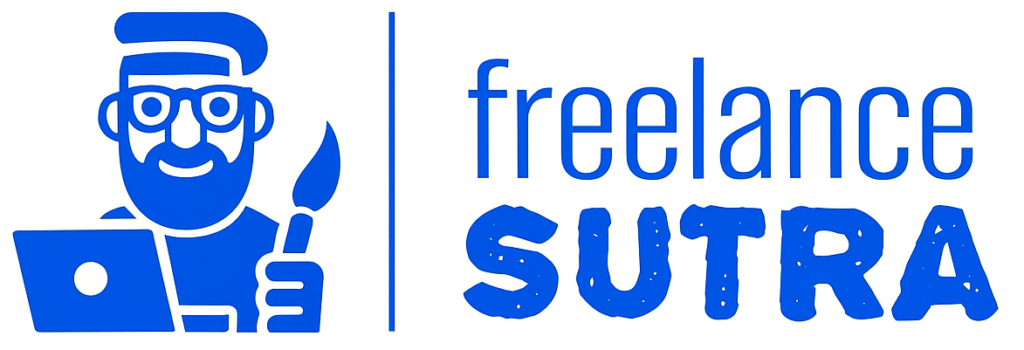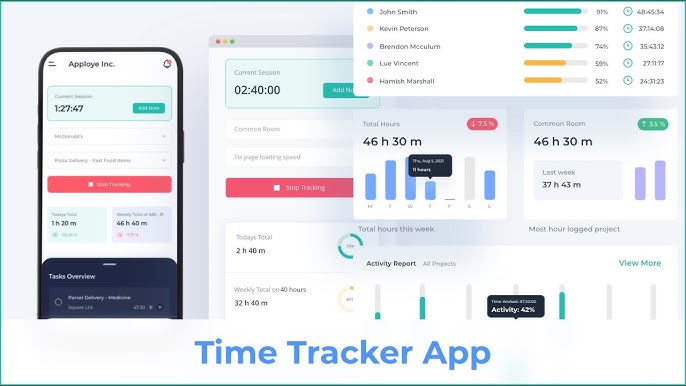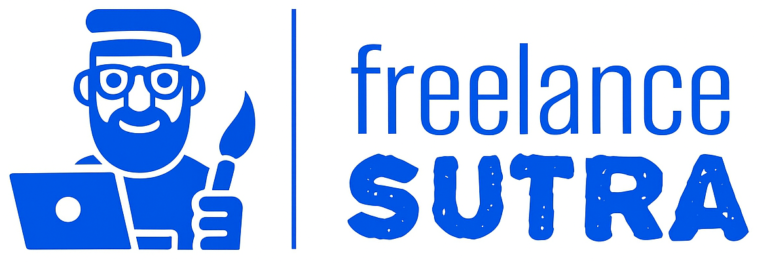Tired of the 9 to 5 and dreaming of working on your own terms?
I’ve been there too.
A few years ago, I sat at my office desk, googling “how to start freelancing”, searching for more flexibility, and more peace.
But jumping into freelancing without a real plan left me juggling random gigs, undercharging, and doubting myself too often.
That’s exactly why I’m writing this blog—not just to list some common freelancing tips for beginners but to share the advice I wish someone had given me when I started.
Whether you are a college student exploring side hustles, a new mom wanting to work from home, or a beginner struggling with where to start, how to find clients,and how to stay consistent, this is the perfect freelancing guide for you.
It doesn’t matter what your background is or what skill you have – Whether you’re a writer, designer, virtual assistant, or developer—these beginner-friendlyfreelancing tips will guide you step-by-step, from setting up your profile to landing high-paying clients.
So, grab a cup of coffee and a notebook and let’s dive into the best freelancing tips for beginners.
1. Choose a specific niche
When you’re starting out, it’s tempting to offer every skill you have to everyone. But the truth is: clients don’t want generalists—they want specialists.
In 2025, when there is a high degree of AI intervention, it is your touch of creativity and understanding of the industry that your clients crave.
Example -A tech startup looking to scale their blog would prefer someone who specifically offers SEO blog writing for B2B SaaS companies over a “content writer”.
Similarly, instead of offering services like copywriting, logo designing, social media marketing, Instagram content strategy , email marketing, UX/UI design and so on. Offer specialised services as an expert rather than a generalist who can do a “little bit of everything”.
For example-
- Copywriting for e-commerce brands launching new product lines.
- UX/UI designing for fintech mobile apps.
- Social Media Marketing for female-led D2C brands.
- Instagram content strategy for beauty influencers.
- Email marketing for coaches and course creators.
The more focused your services are, the easier it becomes to attract the right clients, the kind who are willing to pay more for your expertise.
Don’t worry!
You don’t have to “pick the perfect niche” right away. Let it evolve naturally as you gain experience. The more you work, the clearer your niche will become.
2. Build a high- converting portfolio
A freelance portfolio is your online resume.
It’s the first impression of your ability to transform your skills into real-life, practical projects. And the best part is, you don’t need paying clients to build one.
You can create sample projects that showcase your skills and style on various online platforms.
For example:
- A content writer can publish mock blog posts on Medium, LinkedIn or a personal blog.
- A designer can upload personal branding concepts to Behance or Dribbble.
- A developer can showcase code on GitHub .
Tips for building a Good freelancing portfolio-
- Show different formats, industries, or problem-solving approaches.
- Add relevant keywords to make it SEO-friendly.
- Add a short summary to describe each project
- Be clear, specific, and feasible.
3. Start with Freelance Platforms
As a beginner freelancer, the easiest way to land your first few clients is by making an optimized profile on trusted freelance platforms.
Upwork, Fiverr, Freelancer.com, Toptal, PeoplePerHour, Contra are some of the most trusted, beginner friendly freelancing platforms.
These platforms offer you both short term as well as long term freelance gigs, hourly projects, networking opportunities with international and remote-first brands.
Pro Tip: To attract your ideal client on these freelancing platforms:
Optimize your profile, add a professional headshot, write a compelling, SEO–friendly bio, use keywords related to your skills like SEO writer for SaaS brands.
4. Ask for testimonials
One of the most important freelancing tips for beginners is to ask the clients for testimonials.
The testimonial is the social proof that validates your expertise and reliability. You can be an experienced talented expert, but testimonial has its own worth.
So, after successfully wrapping up a project or even while working on the project you can politely ask for a short review. Don’t wait until you’ve worked with 10 clients. Even your very first project deserves a testimonial.
And once you get testimonials, add them to your website, LinkedIn, profile on various platforms as this is going to be the currency of trust in your freelancing journey.
5.Learn to write winning proposals
While reaching out to clients, think of having a heart-to-heart conversation with your clients, don’t be generic, and brag about “what you are good at”, instead show them “how you can help them”.
Your clients are busy people, so your pitch should be on point.
Customize each proposal for every client, state how well you understand their problem, how you can solve their problem, and how your skills and experience can make the difference they are looking for.
Lastly, always add a strong Call-to-action in the end. Whether it’s scheduling a follow-up call, approving the project, or signing on the dotted line, make the next step effortless and obvious.
6. Network with other freelancers
As a beginner, freelancing can feel like a boring, solo journey. Because everything can be done at the comfort of your quiet home office. But you know what, networking with other freelancers can open new doors for you.
You can have access to referrals, collaborations, useful insights, and emotional support.
Becoming a part of a freelancing community can bring you more projects, because not everyone can do everything. In a community, each freelancer can leverage his/her own expertise.
Here’s a list of spaces where you can find genuine online connections –
- LinkedIn Groups
- Facebook groups
- Discord Communities
- Local networking events
- Slack communities
- Co-working spaces
- Alumni networks
7. Invest in Learning
As a freelancer, upskilling is non-negotiable. It’s an investment that helps you to stay updated in this ever-changing market. Regular upskilling boosts confidence, expandsyour horizons, adds to your existing perspectives, and promises a thriving future.
In 2025, we are flooded with resources that can keep us updated, informed, and competitive
Here’s a list of resources offering structured yet self-paced learning courses:
- Coursera
- Udemy
- Skillshare
- Youtube
- Podcasts
- Newsletters
- Webinars
- Online workshops
- Blogs
8. Set Competitive pricing
As a beginner, “how to set price for freelance projects” is the most confusing question out of all.
The best freelance pricing tip that I can share is, research what other freelancers with similar skills and experience are charging, which will give youan idea of the industry price.
Always consider your expertise, experience, and project’s complexity.
Competitive pricing isn’t about being the cheapest; it’s about valuing your work accurately, so you attract the right clients.
Always charge according to the value you invest rather than an hourly basis, or by the word basis. Remember, you are a beginner not a rookie, be confident in your skills.
9. Use contracts for every project
In freelancing, contracts aren’t optional, in fact, they’re essential.
For, every single project, no matter how small, have a clear written agreement. This document must define the scope of work, deliverables, timelines, and payment terms.
It avoids misunderstandings down the road and ensures everyone’s on the same page.
Make sure the contract is duly signed digitally by both the parties of the project and is renewed in a timely manner with modifications, if required.
10. Set Clear Boundaries
One of the biggest challenges for freelancers is not knowing when to switch off, and how to say no. Setting clear working hours and open communication with the clients is a must.
Decide when you’ll respond to emails or take calls. It’s okay to say “no” to unreasonable requests and repetitive revisions beyond the limits of your contract.
Establishing boundaries isn’t being difficult; it’s about respecting your time which ultimately makes you a more effective freelancer.
11. Streamline Your Payments
While working as a freelancer, make sure you set up a professional, efficient payment system from day one.
Whether it’s online invoicing software, secure payment gateways, or direct bank transfers, make it easy for clients to pay you.
Clearly state your payment terms (e.g., 50% advance, net 30 days after final submission) on your invoices to avoid awkward chases and getting ghosted after your submissions.
12. Streamline freelancing with effective system
In freelancing, there are a lot of repetitive tasks that require specific documents, and creating documents for every client can be time-consuming and will hamper your core operations.
To save your precious time and work more effectively, create templates for repetitive tasks like proposals, invoices, welcome emails, follow-up messages, and even project brief questionnaires.
A professional template not only speeds up your workflow but also ensures consistency and a polished brand image every single time.
13. Track Your Wins with KPIs
While working with different clients, always check key performance indicators (KPIs) beyond just your income.
For example-
- How much time do you spend on each project?
- Which services are most profitable?
- How well are you retaining clients?
Tracking these metrics helps you understand your business’s position, identify areas for improvement, and gives you metrics for better decision-making.
14.Outsource Low-Value Tasks as You Grow
As your business takes off, don’t try to do everything yourself. Because low-value repetitive tasks will hamper your productivity, kill your time, and will disturb your workflow.
Identify tasks that consume your time but don’t directly generate high income (e.g., admin tasks, social media scheduling, basic bookkeeping). Then, outsource these to a virtual assistant.
This frees you up to focus on high-value client work and strategic growth which can help you scale smartly.
15.Respond Promptly & Professionally
The way you communicate with a client leaves a long -lasting impression. In the fast-paced freelance world, quick and polite communication sets you apart.
Always aim to respond to client inquiries and emails within a few hours, or at least within one business day.
Follow the 3P’s – Prompt, Polite and Professional while replying your clients. This will ensure that you are perceived as reliable, organized, and serious about your work.
16.Create an onboarding Welcome Kit
The way you onboard a client matters a lot.
It reflects your professionalism, gives a clear idea of your working style and ethics. So, as a beginner freelancer, prepare a “welcome kit” that includes everything your clients need to know:
your process, communication guidelines, what you need from them, FAQs, and next steps. A smooth onboarding experience reduces client anxiety and sets the stage for a smooth working relationship.
17. Master the art of follow-up
When your freelancing journey soars higher, don’t forget your past clients, because a client retained is a client earned.
Don’t ghost a client after finishing a project. Regularly check in with past clients – a quick email asking how they’re doing, sharing a relevant article, or simply reminding them you’re available.
These follow- ups are essential for repeat business, testimonials, and word-of-mouth referrals.
18. Handle every rejection gracefully
Rejections are inevitable in freelancing.
No doubt, freelancing offers you flexibility, comfort, and freedom; it also comes with a lot of uncertainties, things not working out, risks and so on.
Not every pitch will land, and that’s okay!
Be prepared for it and be consistent. Instead of taking it personally, see it as an opportunity, a stepping stone.
When rejected, thank your client for their time, ask for feedback if appropriate, and move on. Maintaining professionalism, even when disappointed, leaves a positive impression and keeps doors open for future opportunities.
19. Build multiple income streams
Relying on one income source can be risky. What if that big project suddenly ends?
That’s why building multiple income streams is a game-changer for freelance stability and peace of mind. Think of interrelated things that you can offer with your skill set.
For example-
selling a digital product (an e-book, a template), offering consultations, starting a paid newsletter, developing an online course, affiliate marketing.
Diversifying your income sources increases your financial security, and provides a wider range of opportunities.
20. Track your finances –
You’re not just a service provider; but the owner, manager and sole proprietor of your business.
Track every single transaction, every cash inflow and outflow. This includes logging income from clients, all your business expenses (software subscriptions, electricity, internet, marketing tools, etc.).
Here’s a list of software options for tracking business finances:
- Zoho Books
- Fresh Books
- ProfitBooks
- QuickBooksOnline
21.Celebrate small wins –
Freelancing can be tough, so it’s crucial to acknowledge your progress. Appreciate yourself for the small milestones like –
- Landing a new client.
- Finish a challenging project ahead of schedule.
- Getting a great testimonial.
These small wins are fuel for your motivation, reminding you of how far you’ve come.
So, there you have it!
21 best freelancing tips for beginners that I truly wish I’d known when I first started this freelancing journey.
Remember, a journey of a thousand miles begins with a single step, and sometimes, that step is just sending one email or creating one sample project.
Don’t aim for perfection right away; aim for progress.
As a beginner freelancer, just be consistent, and always think long-term. Embrace the learning curve, stay curious, and most importantly, enjoy the incredible freedom that freelancing can bring.
FAQs
1. I’m scared to start. What’s the absolute first step?
Pick one skill you’re good at, create a simple online portfolio (even with mock projects), and start telling everyone you’re open for freelance work.
2. Besides online platforms, where else can I proactively look for freelance work?
Explore local business networking events, join industry-specific online communities and forums, leverage your personal LinkedIn connections, cold-email businesses you admire with customised proposals showcasing how you can solve a specific problem for them.
3. What if I make a mistake on a project?
Be honest, take responsibility, and offer a solution to fix it. Most clients appreciate honesty and a willingness to make things right.
4. Do I need a degree to be a successful freelancer?
Not at all! Freelancing needs practical skills, experience, and a strong portfolio. Clients care more about your ability to deliver results.
5. Should I quit my day job right away to freelance?
It’s much safer to start freelancing on the side while you still have your regular income. Once your freelance income is stable, then consider the jump.







